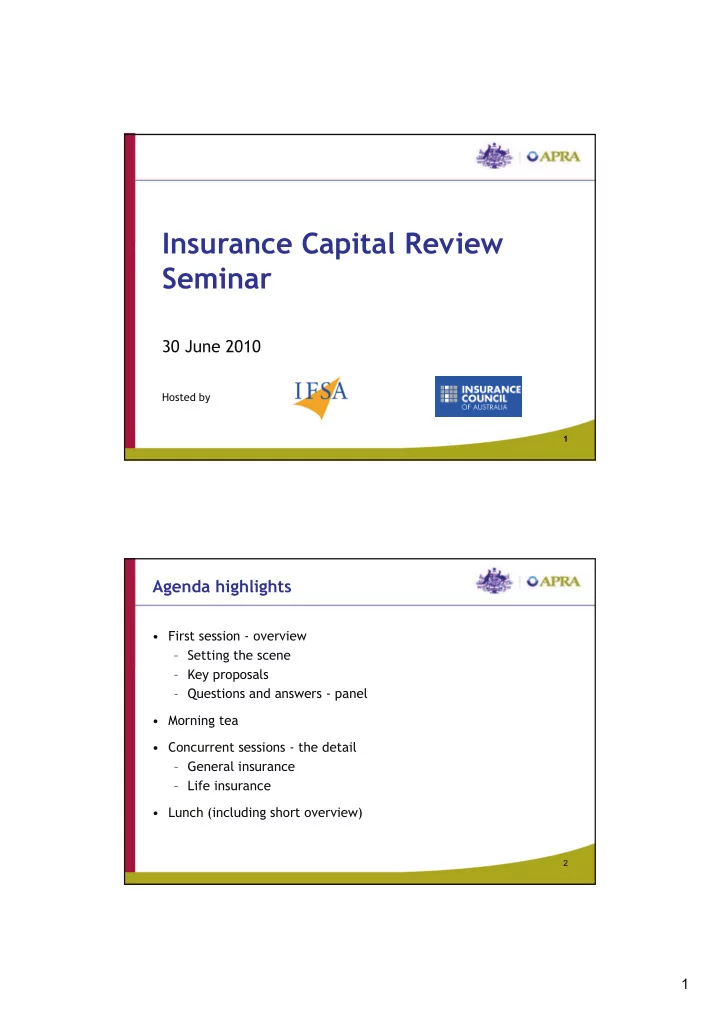

Insurance Capital Review Insurance Capital Review Seminar 30 June 2010 30 June 2010 Hosted by 1 Agenda highlights • First session - overview – Setting the scene – Key proposals – Questions and answers - panel • Morning tea • Concurrent sessions - the detail – General insurance – Life insurance • Lunch (including short overview) 2 1
Objectives of the review • Review the risk sensitivity and appropriateness of the capital standards standards • Improve alignment of capital standards for general insurance and life insurance industries and with ADIs, where appropriate • Monitor international regulatory developments l l d l 3 Proposed capital concepts Inadmissible Assets Surplus Capital Capital Base Required Capital Admissible Assets Other Liabilities Insurance Insurance Liabilities 4 2
Capital base • Capital base to exceed required capital at all times • For Life: • For Life: – Replacement of solvency & capital adequacy with one capital requirement – Introduce concept of ‘eligible capital base’ – Inadmissible assets reduce capital base – Asset concentration included in required capital – Harmonise with GI/ADI ‘Tier 1/Tier 2’ but… • Will finalise proposals for Tier1/Tier 2 capital once international position is clearer 5 Components of required capital Aggregation Operational risk Supervisory benefit benefit Adjustment Adj Asset concentration risk Total Prescribed Asset risk required capital capital Total amount amount Require Insurance d Concentration Concentration Capital risk Insurance risk 6 3
Prescribed capital amount defined Prescribed capital amount comprises of capital charges for: • Asset risk • Asset concentration risk Asset concentration risk • Insurance risk • Insurance concentration risk • Operational risk An aggregation benefit is then applied to produce the prescribed capital amount p p • No Expense or New Business Reserves (change for Life) • Internal models – will consider for Life (no change for GIs) 7 Asset risk capital charge • Currently ‘resilience reserve’ for Life; factor-based calculation for GI • Propose to revise the resilience reserve (renamed ‘asset risk Propose to revise the resilience reserve (renamed ‘asset risk capital charge’) and use for both Life and GI • Charge is based on a series of stress tests applied to the balance sheet using parameters specified by APRA • Capital required for each risk will be the change in net assets • Capital required for each risk will be the change in net assets for a specified stress • These net asset movements combined via correlation matrix (to be specified by APRA) provide the overall capital requirement 8 4
Asset concentration risk capital charge • GI proposals: – tighter limits on large investment exposures – broadly tighter limits on large investment exposures broadly aligning with ADIs – reinsurance limits unchanged • Life proposals: – similar to existing requirements – reduce concentration limits for specialist reinsurers retroceding to parent – require specialist reinsurers to hold direct and reinsurance business in separate statutory funds 9 Insurance risk charge • GIs – minor adjustment to classification of classes • Life • Life – similar to existing standards – will now include an assessment of extreme events • Risk free rate: CGS the best proxy for risk free rates – may allow liquidity premium in limited cases may allow liquidity premium in limited cases 10 5
Insurance concentration risk charge • Life – included in Insurance Risk Charge (allowance for extreme included in Insurance Risk Charge (allowance for extreme events) • GI – current principle: maintain adequate capital to withstand one large event - MER – proposals still being developed – further discussion in l till b i g d l d f th di i i concurrent session this morning 11 Components of required capital Aggregation Operational risk Supervisory benefit benefit Adj Adjustment Asset concentration risk Total Prescribed Asset risk required capital capital Total amount amount Require Insurance d Concentration Concentration Capital risk Insurance risk 12 6
Operational risk charge • APRA proposes introducing an explicit operational risk charge as a component of prescribed capital • This is consistent with the principle of improving risk sensitivity • Operational risk charge to be based on exposure measures (e.g. premium, liabilities, FUM) • Details will be released with QIS 13 Aggregation benefit • Current requirements do not directly allow for the diversification that may exist between risk types y yp • APRA proposes an explicit allowance for diversification between asset and insurance risks only • Level to be set by APRA • Will reduce required capital for insurers exposed to both risks 14 7
3 Pillars Pillar 1 Pillar 2 Pillar 3 Q Quantitative Supervisory p y Disclosure requirements review process requirements Supervision of: for required Designed to • risk mgt capital, eligible encourage market capital and • capital mgt discipline liability valuations May include a supervisory adjustment to capita l 15 Supervisory review and assessment • Insurers should have process to assess and manage capital manage capital • ICAAP requirements build on current requirements • APRA Pillar 2 adjustment to required capital or capital base only one supervisory tool capital base only one supervisory tool 16 8
Disclosure • Required capital consists of – a prescribed capital amount determined in accordance with the quantitative rules set out in APRA standards; and the quantitative rules set out in APRA standards; and – an additional capital amount in the nature of a supervisory adjustment that may be required by APRA • Disclosure of – prescribed capital amount and components – capital base and components 17 Proposed timetable • Nov 2009 Informal industry consultation • May 2010 First discussion paper issued • Jul 2010 J l 2010 T Technical papers issued h i l i d • Jul-Oct 2010 Quantitative impact study period • Aug 2010 Deadline for first discussion paper comments • Dec 2010 Draft standards and second discussion paper issued p p • 2011 Final standards and reporting forms issued • 2012 Implementation 18 9
Panel discussion 19 10
Recommend
More recommend